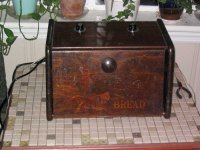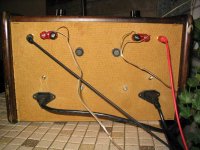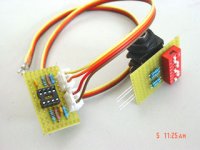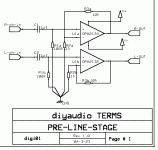I finally rewired my Gainclone (previously referred to as the "Ghettoclone") and found a more suitable enclosure.
The breadbox was the perfect size. I am able to house the entire amplifier (transformers and all) in one box .
.
Thanks to all for the encouragement and the guidance. I'm really happy with the amp-- I think it sounds great. Now all I need is a line stage preamp. Any suggestions?
Kofi
The breadbox was the perfect size. I am able to house the entire amplifier (transformers and all) in one box
Thanks to all for the encouragement and the guidance. I'm really happy with the amp-- I think it sounds great. Now all I need is a line stage preamp. Any suggestions?
Kofi
Attachments
Well... I have to admint that I went with the SPST-- just lazy.
Yes, I know I need good interconnects and speaker wires, but I gotta get through one thing at a time. Besides, Mrs. Annan needs me to help her with her knitting blog.
Ain't that emasculating?
Since you mentioned it, what would you recommend for cheap(er) interconnects and / or good speaker wire? I would gladly make some myself (I've been to the TNT Audio site and it doesn't look too hard), but I'm not certain that purchasing the damn things wouldn't be cheaper and easier?
Any thoughts?
Kofi
Yes, I know I need good interconnects and speaker wires, but I gotta get through one thing at a time. Besides, Mrs. Annan needs me to help her with her knitting blog.
Ain't that emasculating?
Since you mentioned it, what would you recommend for cheap(er) interconnects and / or good speaker wire? I would gladly make some myself (I've been to the TNT Audio site and it doesn't look too hard), but I'm not certain that purchasing the damn things wouldn't be cheaper and easier?
Any thoughts?
Kofi
After a brief review of you cabling, might I sugest that Romex would be an improvement. Perhaps you could have Mrs. A knit up something out of some UTP. (Don't mention a word to anybody, but I am using the cheapest Monster cables that come with the gold plated RCA's). I think they're just fine. Cetainly better than those free turds (featured above) that come with the $49.95 VCR. Someday (perhaps after a felony conviction in an effort to do "good time") I'll braid my own speaker cables. I'm just not quite that lonely and bored yet.
If bored and lonely is a requirement for DIY interconnects then, HERE COMES KOFI!
Digi, your circuit looks a lot neater than mine. You'll notice that I did not include pictures of my wiring. This is by design.
Anyway, I'm sure that this question has already been asked and answered somewhere on this forum, but I'll ask anyway. Do speaker / interconnect cables really make a big difference?
Please bear in mind that I have recently moved my feedback resistor, input caps and filter caps closer to the chip and I have not noted any difference in the sound (however, I have noticed that all but the slightest amount of buzz has disappeared)... so maybe the question is this:
Will someone with an ear unaccustomed to subtle nuance be able to tell the difference between good cables and found-at-a-yard-sale-and-manufactured-by-Radio-Shack cables?
Also, for speaker cables, what do you use? I just have speaker cable that's called "speaker cable".
Kofi
Digi, your circuit looks a lot neater than mine. You'll notice that I did not include pictures of my wiring. This is by design.
Anyway, I'm sure that this question has already been asked and answered somewhere on this forum, but I'll ask anyway. Do speaker / interconnect cables really make a big difference?
Please bear in mind that I have recently moved my feedback resistor, input caps and filter caps closer to the chip and I have not noted any difference in the sound (however, I have noticed that all but the slightest amount of buzz has disappeared)... so maybe the question is this:
Will someone with an ear unaccustomed to subtle nuance be able to tell the difference between good cables and found-at-a-yard-sale-and-manufactured-by-Radio-Shack cables?
Also, for speaker cables, what do you use? I just have speaker cable that's called "speaker cable".
Kofi
Kofi,
Providing your interconnects are not too long I would go with a passive preamplifier built into the breadbin, you probably have plenty of space in there It would consist of a volume control (or a stepped attenuator which does a much better job for a bit more cost) and, optionally, a source selector switch. Keep all this close to the chips and you have a very nice sounding 'integrated' amp. This is the setup I use with my 8ohm transmission line speakers.
It would consist of a volume control (or a stepped attenuator which does a much better job for a bit more cost) and, optionally, a source selector switch. Keep all this close to the chips and you have a very nice sounding 'integrated' amp. This is the setup I use with my 8ohm transmission line speakers.
In my experience, speaker cables and interconnects do make a difference - the improvement between a really cheap cable and a slightly more expensive one (say the difference between $5 and $45) is quite marked: you will probably notice much more detail in the sound. Then again, stepping up from $40 - $100 the diference, IMHO, is not really very noticeable. However, you can make your own (speaker cable or interconnects) very cheaply from CAT5 internet cable, and yes, it will sound much better than $5 bought cables (but cost less).
Using banana plugs for your speaker cables won't improve the sound but will make them much easier to plug in/unplug
Providing your interconnects are not too long I would go with a passive preamplifier built into the breadbin, you probably have plenty of space in there
In my experience, speaker cables and interconnects do make a difference - the improvement between a really cheap cable and a slightly more expensive one (say the difference between $5 and $45) is quite marked: you will probably notice much more detail in the sound. Then again, stepping up from $40 - $100 the diference, IMHO, is not really very noticeable. However, you can make your own (speaker cable or interconnects) very cheaply from CAT5 internet cable, and yes, it will sound much better than $5 bought cables (but cost less).
Using banana plugs for your speaker cables won't improve the sound but will make them much easier to plug in/unplug
Cool! Thanks for the recommendation. I will probably try and make the cables... I think that the TNT Audio site offers some pretty explicit instructions, so I'll start there for my tutorial.
Also, I'm not sure where I would begin for the passive preamp (yes-- I do have plenty of room in the breadbox). Are there any designs you'd recommend? I already have a cheap phono preamp (the Bugle from Hagerman Tech) that I will probably keep outside of the box.
I have been interested in stepped attenuators for some time, but they all seem really expensive ($100+ US). Are there cheaper alternatives for attenuators? How hard are they to wire together or can I get one already wired?
Kofi
Also, I'm not sure where I would begin for the passive preamp (yes-- I do have plenty of room in the breadbox). Are there any designs you'd recommend? I already have a cheap phono preamp (the Bugle from Hagerman Tech) that I will probably keep outside of the box.
I have been interested in stepped attenuators for some time, but they all seem really expensive ($100+ US). Are there cheaper alternatives for attenuators? How hard are they to wire together or can I get one already wired?
Kofi
Although it's called a 'passive preamp' it's really just a volume control, so don't feel put-off. And it's not that hard to make a stepped attenuator - have a look at Nuuk's site ( http://www.decdun.fsnet.co.uk/gaincloneFAQ.html ) - at the bottom of this page it tells you how to make a st/a, and include a source selector switch if you want. You will need a switch mechanism (to hold the wafers), wafers (to solder the resistors to), spacers (to keep the wafers the correct distance apart) and the resistors (these do the attenuating).
Just remember as the resistance increases, so does the volume level, to quote Nick..
If you are new to electronics, this may seem a bit strange - increasing resistance but the sound level also increases! This is because the resistance to ground is increasing as the volume control is turned 'up', not the resistance between the 'in' and 'out' sections of the attenuator circuit. As the resistance to ground increases, it 'forces' more of the signal to flow to the 'out' connection and the sound level increases.
In the UK a st/a will cost around £25GBP to diy, using good quality resistors, and will not interfere with the signal in the way a standard potentiometer will. Your phono preamp could be connected to the attenuator/amp by interconnects, or if it is small enough you could stick that to the inside of the breadbox also to retain that marvellous feeling of completeness that you only get from a good integrated
Just remember as the resistance increases, so does the volume level, to quote Nick..
If you are new to electronics, this may seem a bit strange - increasing resistance but the sound level also increases! This is because the resistance to ground is increasing as the volume control is turned 'up', not the resistance between the 'in' and 'out' sections of the attenuator circuit. As the resistance to ground increases, it 'forces' more of the signal to flow to the 'out' connection and the sound level increases.
In the UK a st/a will cost around £25GBP to diy, using good quality resistors, and will not interfere with the signal in the way a standard potentiometer will. Your phono preamp could be connected to the attenuator/amp by interconnects, or if it is small enough you could stick that to the inside of the breadbox also to retain that marvellous feeling of completeness that you only get from a good integrated
ON the topic of interconnects, I agree there is a big difference between the 5 dollar Radio Shack stuff and the fancier stuff. I bought the Monster stuff on ebay. They might have been twenty five bucks or less. I think there the most significant difference is the gold (easily maleable over the bulkhead connector) and the shield (to help keep the funky 60Hz stuff out).
As for the $200 variety, who cares. I can't afford them. As for the UTP braid jobs, it's interesting and appeals to me from the standpoint of physical laws. One of my two GC's will be built with UTP inputs & outputs. My plan is to use the "good stuff" for one and the "funky stuff" for the other. Toroid on one, c-frames on the other. Stranded-solid, twisted pair vs.solid, aluminum vs. steel. Then I can have my own experiment.
As for the $200 variety, who cares. I can't afford them. As for the UTP braid jobs, it's interesting and appeals to me from the standpoint of physical laws. One of my two GC's will be built with UTP inputs & outputs. My plan is to use the "good stuff" for one and the "funky stuff" for the other. Toroid on one, c-frames on the other. Stranded-solid, twisted pair vs.solid, aluminum vs. steel. Then I can have my own experiment.
OK-- I think I'll try to make some cables from CAT 5.
Also, I don't really understand the concept of the passive preamp. I have potentiometers for volume control on my GC, so are you saying that I would replace those with one stereo stepped attenuator, or that I would need to rig up the attenuator in addition to the pots?
If its the former, where would the power for the preamplification come from?
Kofi
Also, I don't really understand the concept of the passive preamp. I have potentiometers for volume control on my GC, so are you saying that I would replace those with one stereo stepped attenuator, or that I would need to rig up the attenuator in addition to the pots?
If its the former, where would the power for the preamplification come from?
Kofi
I see; you already have volume controls included in your amp and you won't necessarily need a preamp. The passive preamp (probably a contradiction in terms) uses no power (hence it is "passive") and this is basically what your existing volume pots are. For systems where all your components are reasonably close together a passive preamp will be fine. An "active" preamp (ie, powered) may add extra depth or weight to the sound, which you may prefer.
If you just want a preamp so you are able to choose between sources this can be done by simply adding a selector switch and some phono sockets straight after the source(s). Again, this is "passive". You can read about it on Nuuk's site, he has covered it all.
A stepped attenuator is basically a better quality volume control than a potentiometer, and you could use one stereo (or two mono) stepped attenuator(s) in place of your existing pots if you want to improve the sound.
Sorry for any confusion

If you just want a preamp so you are able to choose between sources this can be done by simply adding a selector switch and some phono sockets straight after the source(s). Again, this is "passive". You can read about it on Nuuk's site, he has covered it all.
A stepped attenuator is basically a better quality volume control than a potentiometer, and you could use one stereo (or two mono) stepped attenuator(s) in place of your existing pots if you want to improve the sound.
Sorry for any confusion
Just like what Ropie is said, pre-stage is not necessary.The advantage of pre-stage make gainclonec have fine right connection character,can meet more signal sources,can regulate the sound according to the need too.
this is my line stage preamp sch.As a guitar effects, insert before the GC pot.
this is my line stage preamp sch.As a guitar effects, insert before the GC pot.
Attachments
Ropie,
Thanks for responding!
I'll try the attenuator in lieu of the pots and let you know what I think-- not that it matters what I think... I'm a little concerned that I will screw it up, though. Will any multi-position switch work? Any one you'd recommend?
Also, I got lazy (again) and went out and bought some monster cables and replaced the Radio Shack (TM) specials I had. It really made a difference in the bass response, but I don't really notice any difference in the highs. Do these things have a break-in period?
I also bought monster speaker wire, but I have yet to hook that up.
Thanks for all the advice! I'm still thinking about a speaker project and if I can find full ranger crivers that are cheap enough, I think I'm going to attempt the J-Low horn (Pass DIY).
Kofi
Thanks for responding!
I'll try the attenuator in lieu of the pots and let you know what I think-- not that it matters what I think... I'm a little concerned that I will screw it up, though. Will any multi-position switch work? Any one you'd recommend?
Also, I got lazy (again) and went out and bought some monster cables and replaced the Radio Shack (TM) specials I had. It really made a difference in the bass response, but I don't really notice any difference in the highs. Do these things have a break-in period?
I also bought monster speaker wire, but I have yet to hook that up.
Thanks for all the advice! I'm still thinking about a speaker project and if I can find full ranger crivers that are cheap enough, I think I'm going to attempt the J-Low horn (Pass DIY).
Kofi
Alright! This looks like a winner. I'll start the long process of convincing Mrs. Annan that this preamp is worthwhile and I'll let you know where I wind up.
Thanks again!
Oh, BTW, I just used the new cables with vinyl and the records actually do sound much better. The bass is "tighter" (I think I'm starting to understand what this means-- more clearly-defined notes, maybe?) and it sounds like the surface noise has been cancelled considerably, although this could be beacuse the GC is now in an enclosure instead of "rockin' a scully" on an open slab of pressboard.
Does this DIY stuff ever end or do you just keep doing it?
Kofi
Thanks again!
Oh, BTW, I just used the new cables with vinyl and the records actually do sound much better. The bass is "tighter" (I think I'm starting to understand what this means-- more clearly-defined notes, maybe?) and it sounds like the surface noise has been cancelled considerably, although this could be beacuse the GC is now in an enclosure instead of "rockin' a scully" on an open slab of pressboard.
Does this DIY stuff ever end or do you just keep doing it?
Kofi
- Status
- This old topic is closed. If you want to reopen this topic, contact a moderator using the "Report Post" button.
- Home
- Amplifiers
- Chip Amps
- Breadbox Gainclone


 ,I like it.
,I like it.
